

Hugh Cuthbertson, the 'Baccy Parson'

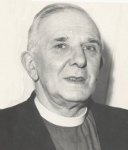
 The
last Vicar of St Paul with St Mark (1963-68) was Hugh Sainsbury Cuthbertson.
Born 1899 in Cambridgeshire where his father was a Congregational
minister, in Linton / Duxford - RAF territory - he trained as an
aircraft draughtsman at Hendon and, living in a cottage in Thaxted,
became
a Christian Socialist and Anglican under the
influence of Conrad
Noel (who was also one of the heroes of Fr Groser and
others at St George-in-the-East), and offered himself for ordination.
Trained at Bishop's College,
Cheshunt, he served curacies in Coggeshall (Essex) and Liverpool before
a spell
as chaplain of Concepción in
Chile from 1929-34, having married Berry Burgess (whom he met during
his time in Hendon).
The
last Vicar of St Paul with St Mark (1963-68) was Hugh Sainsbury Cuthbertson.
Born 1899 in Cambridgeshire where his father was a Congregational
minister, in Linton / Duxford - RAF territory - he trained as an
aircraft draughtsman at Hendon and, living in a cottage in Thaxted,
became
a Christian Socialist and Anglican under the
influence of Conrad
Noel (who was also one of the heroes of Fr Groser and
others at St George-in-the-East), and offered himself for ordination.
Trained at Bishop's College,
Cheshunt, he served curacies in Coggeshall (Essex) and Liverpool before
a spell
as chaplain of Concepción in
Chile from 1929-34, having married Berry Burgess (whom he met during
his time in Hendon).
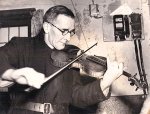


 It's
said that he believed that this post, advertised
as 'chaplain to the Falkland Islands', was off Scotland, which the
thought would have made a good place to live for a time - but they went
anyway (shades of William Quekett's appointment at
St George's)! They
returned because of his father's ill-health, Betty's trek on horseback
across the Andes to Buenos Aires bringing them some notoriety, and
first-class passage home. In two further curacies in London (Stoke
Newington and St Pancras), and spells in hospital chaplaincy, he
put his values into practice as secretary of the English
branch of the left-wing Film
and
Photo League
from
1936-39 (which among other projects filmed the hunger march from
Scotland to London): it was a disorganised and overstretched movement,
and he
invested much energy into keeping it going until war broke out. Keen
on flying (from his background), he then
undertook civil air guard training at the London Air Park Flying Club
and gained the Royal Aero Club's
aviator's certificate in June 1939, of which he was very proud [right].
It's
said that he believed that this post, advertised
as 'chaplain to the Falkland Islands', was off Scotland, which the
thought would have made a good place to live for a time - but they went
anyway (shades of William Quekett's appointment at
St George's)! They
returned because of his father's ill-health, Betty's trek on horseback
across the Andes to Buenos Aires bringing them some notoriety, and
first-class passage home. In two further curacies in London (Stoke
Newington and St Pancras), and spells in hospital chaplaincy, he
put his values into practice as secretary of the English
branch of the left-wing Film
and
Photo League
from
1936-39 (which among other projects filmed the hunger march from
Scotland to London): it was a disorganised and overstretched movement,
and he
invested much energy into keeping it going until war broke out. Keen
on flying (from his background), he then
undertook civil air guard training at the London Air Park Flying Club
and gained the Royal Aero Club's
aviator's certificate in June 1939, of which he was very proud [right].

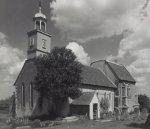
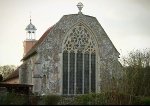 From
1941 Cuthbertson
was Vicar of Tilty Abbey church in Essex
(between Great Dunmow and Thaxted - his theological 'mecca') - left then and now.
They filled the vicarage with evacuees; he organised allotments,
'salvage stewards' and the 'parish invasion committee'. Right is his signature in
his copy of Songs of Praise.
From
1941 Cuthbertson
was Vicar of Tilty Abbey church in Essex
(between Great Dunmow and Thaxted - his theological 'mecca') - left then and now.
They filled the vicarage with evacuees; he organised allotments,
'salvage stewards' and the 'parish invasion committee'. Right is his signature in
his copy of Songs of Praise.
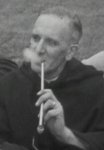
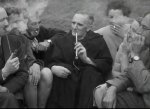
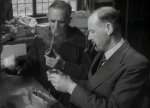
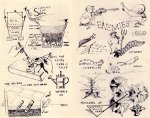
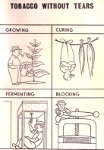
 Here
he
achieved a certain notoriety as the 'Baccy Parson': London Calling,
BBC
1951, and 1948 Pathé newsclip Wot
- No Cigarettes? - stills left -
establishing a smokers' co-operative for the growing and curing
of tobacco (a skill he had learnt in Chile) when tobacco was in short
supply after the War. He began this to raise
funds
to repair the tower of Tilty church; it was so successful that it also
financed the replacing of three windows in the west wall [right with some of the responses
received to his appeal for 5s. contributions, in return for which he
sent information on home-growing. The soubriquet was one that he didn't
particularly relish, but like Woodbine Willie, cam to
accept it as affectionately intended.
Here
he
achieved a certain notoriety as the 'Baccy Parson': London Calling,
BBC
1951, and 1948 Pathé newsclip Wot
- No Cigarettes? - stills left -
establishing a smokers' co-operative for the growing and curing
of tobacco (a skill he had learnt in Chile) when tobacco was in short
supply after the War. He began this to raise
funds
to repair the tower of Tilty church; it was so successful that it also
financed the replacing of three windows in the west wall [right with some of the responses
received to his appeal for 5s. contributions, in return for which he
sent information on home-growing. The soubriquet was one that he didn't
particularly relish, but like Woodbine Willie, cam to
accept it as affectionately intended.
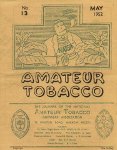
 When
rationing and shortages ended, he was able to tap
into the
modest
post-war craze for home-growing tobacco, to save both import charges
for the nation and pocket
money for
individuals
(compare the exhortations of J.C.
Pringle,
Rector at St George-in-the-East a generation earlier, to buy Rhodesian
rather than American tobacco). But he was watched warily and with
some disapproval by customs and
excise officials. He became President of the National Amateur
Tobacco Growers' Association (see here for the firm that
published their material), and produced a magazine The Smoker.
The
Association shared knowledge and experience of growing and curing, sold
plants in the spring,
and offered a postal curing service.
When
rationing and shortages ended, he was able to tap
into the
modest
post-war craze for home-growing tobacco, to save both import charges
for the nation and pocket
money for
individuals
(compare the exhortations of J.C.
Pringle,
Rector at St George-in-the-East a generation earlier, to buy Rhodesian
rather than American tobacco). But he was watched warily and with
some disapproval by customs and
excise officials. He became President of the National Amateur
Tobacco Growers' Association (see here for the firm that
published their material), and produced a magazine The Smoker.
The
Association shared knowledge and experience of growing and curing, sold
plants in the spring,
and offered a postal curing service.
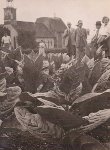
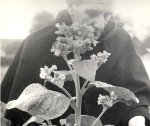

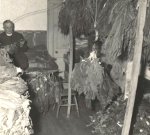
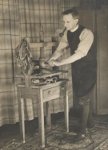 Left are some images of the Tilty
enterprise. At his Harvest service
in 1944, he distributed free beer in the parish hall after the service.
Tilty is a very little hamlet of only 20 or 30 souls, he
said, but
it has quite a nice history as an English agricultural village, and I
think that the harvest home service and the beer will be nicely in
keeping with its traditions. As for where I shall get the beer I am not
saying, except that it will not be on the black market.
Left are some images of the Tilty
enterprise. At his Harvest service
in 1944, he distributed free beer in the parish hall after the service.
Tilty is a very little hamlet of only 20 or 30 souls, he
said, but
it has quite a nice history as an English agricultural village, and I
think that the harvest home service and the beer will be nicely in
keeping with its traditions. As for where I shall get the beer I am not
saying, except that it will not be on the black market.
He argued that home-cured tobacco was 'healthier' than commercial products. In the British Medical Journal 'Notes and Comments' for 5 February 1949, he wrote
| Your reply on the subject of amblyopia and home-cured tobacco (Any Questions? Jan 22 p.163) vindicates the position I have always taken on the importance of a fermentative process. This is recommended in the literature of the National Amateur Tobacco Growers' Association, as also the removal or crushing of the mid-rib. Plans were made last year to provide for facilities for bulk fermentation under professional guidance, but had to be abandoned for the time being owing to the intervention of Customs and Excise. This does not mean that small-scale methods such as can be carried out in the home are not adequate or that there is any justification in the wording of your article for the misleading headlines in the national Press on the 'danger' of home-grown. Some moths ago a charge of high nicotine content in home-grown leaf was made by the Press, but my challenge to produce evidence was never met. You will realize, as we do, that some interests are prejudiced against the reputation of garden grown, indeed of any European, lead. In point of fact, most imported tobacco sold in this country does not, I believe, go through any process of fermentation except as naturally occurs in bond. We would like further information on this, and also whether the data you give on amblyopia on the Continent refer only to smoking or include the chewing of tobacco. A leaflet is now in the printer's hands on the subject of fermentation of amateur tobacco, a copy of which we should be pleased to send to correspondent with any other information they require. The association would give whatever co-operation and assistance it can in research on the subject. |
| Sunday -
Holy Communion 8am and 10am (sung) with Confirmation/Bible Classes at
11.30am, Evensong 6.30pm (4pm with Baptisms, first Sunday of the month) Weekdays - Holy Communion as announced Clubs (at Church House) - 'Senior Mixed' Fridays at 8.00pm; 'Junior Mixed' Thursdays at 6.30pm, 'Church Children' Saturdays at 4.00pm Magazine - bi-monthly Church News, incorporating The Pilot. Church open for prayer and visitation on Wednesdays, 12-2pm, and the key may be obtained at other times from the Vicarage by responsible persons. Contacts or visits from any who work in the district will always be welcomed. |
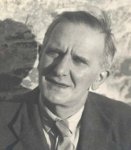

 Hugh Cuthbertson retired to
Tilty after five years, living in the former vicarage. His letter
heading (according to Ken Leech) still proclaimedTilty Tobacco Co-operative, Proprietor The
Revd Hugh Cuthbertson FRHS, 11 Dock Street,
which may have
puzzled some. He died in Uttlesford, Yorkshire in 1976 aged 77 (Betty
having died the previous year).
Hugh Cuthbertson retired to
Tilty after five years, living in the former vicarage. His letter
heading (according to Ken Leech) still proclaimedTilty Tobacco Co-operative, Proprietor The
Revd Hugh Cuthbertson FRHS, 11 Dock Street,
which may have
puzzled some. He died in Uttlesford, Yorkshire in 1976 aged 77 (Betty
having died the previous year).

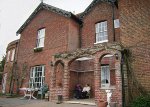 The
Tilty Tobacco
Centre
and Curing Co-operative continued in the hands of his daughter, Cecily
(Cecile) Down - left - at Abbey Gates, the former vicarage - right - curing tobacco
for the
cartoonist Zac among others. As a child she had been impatient of the
time her father spent with his tobacco plants; he is said to have
replied, in the words of James Russell Lowell, Blessed are the horny hands of toil. The co-operative finally closed in 2013.
The
Tilty Tobacco
Centre
and Curing Co-operative continued in the hands of his daughter, Cecily
(Cecile) Down - left - at Abbey Gates, the former vicarage - right - curing tobacco
for the
cartoonist Zac among others. As a child she had been impatient of the
time her father spent with his tobacco plants; he is said to have
replied, in the words of James Russell Lowell, Blessed are the horny hands of toil. The co-operative finally closed in 2013.
Press stories
about home tobacco growing and curing continued to appear; for example,
in the Rochdale Observer on 4 August 2007:
| Weeds may be the bane
of gardeners' lives, but to one Norden man they
were treated with as much care as any prize rose and were worth their
weight in gold. The 'weed' in question was tobacco and it saved grower
Arthur Buckley,
who was featured in The
Observer in 1973, plenty of money. Mr Buckley was not allowed by
law to sell the home-grown tobacco, or
even give it away. He had been growing the plant for about 20 years and
his crop in 1973 was a bumper one - his 100 plants had produced about
10lbs of tobacco. Not a bad return on £4 - the cost of the plants
bought from the Rev
Hugh Cuthbertson of Dunmow, Essex, originator of grow your own
tobacco.
Mr Buckley said the growth was quick, especially in warm, sunny
weather. The lower leaves ripened first towards the end of August, and
the crop was 'harvested' at the end of October, hanging the leaves to
dry and being careful they didn't touch. The leaves were then stacked
in cardboard boxes, taken out as required,
and 'cooked' using a home-made contraption of an aluminium container
with electric light bulb heating. The cooker drove out the excess
tannin, nicotine and tar, but the
process gave off an obnoxious smell. When the offending smell reduced,
the tobacco was ready. The next stage was the 'clamping' and perfuming
rthe leaves with a mixture of liquorice, treacle, honey and rum
essence. Mr Buckley said growing his own tobacco had left him with six
years of
stock. At the time of the story he was smoking his 1969 stock. His
advice to the new grower was: Have
patience. |
Fr
Jack Boggis
succeeded Hugh Cuthbertson as incumbent of Tilty and its neighbouring
churches in 1963 until his death five years later, continuing the
Christian Socialist connections of the area.
Back to St Paul Dock Street | Back to Clergy 1900-